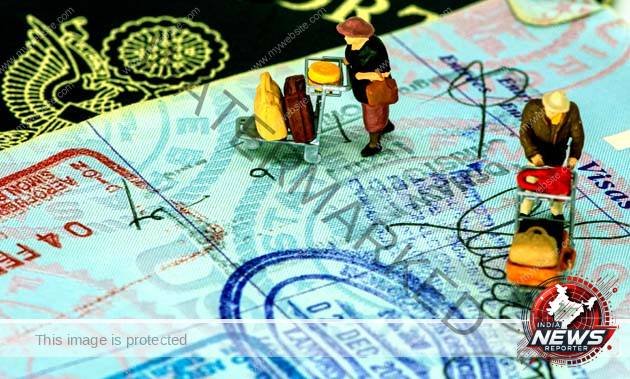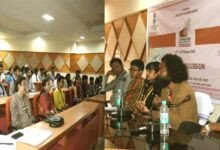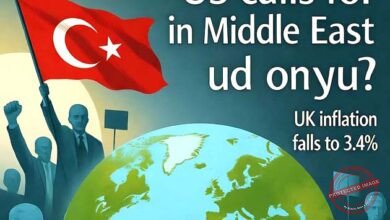
New Delhi (India News Reporter). The Impact of Trump’s Visa Policies on Indians in the US: The presidency of Donald Trump marked a significant turning point in the realm of immigration policy within the United States. Trump’s administration introduced a series of visa policies aimed at reshaping immigration processes, with a particular focus on reducing the influx of foreign nationals. The alterations made to visa categories, especially H-1B and student visas, have had a profound impact on various demographic groups, including Indian nationals, who constitute a significant portion of the immigrant workforce in the tech sector.
One of the most notable changes under Trump’s visa policies was the tightening of the H-1B visa application process, which is specifically designed for skilled workers. This visa is crucial for many Indian professionals seeking employment in the U.S. tech industry. Increased scrutiny of applications, coupled with higher minimum salary requirements, made it more challenging for companies to sponsor these visas. Such alterations sent waves of uncertainty among Indian nationals, who previously relied on this visa pathway for opportunities in the United States.
Furthermore, the administration’s focus on “America First” policies led to the implementation of travel bans affecting certain countries with high Muslim populations. Although the ban did not directly target India, the atmosphere of uncertainty and changing appraisals of immigrant contributions caused apprehension in the Indian community as well as among potential immigrants contemplating the move to the U.S.
In addition to work-related visas, Trump’s policies affected student visas through enforcement of stricter rules, which hindered the opportunities for Indian students seeking educational experiences in the U.S. through programs like OPT (Optional Practical Training). This shift in U.S. immigration policy not only affected the present circumstances of Indian nationals but could also shape future immigration trends, leading to broader implications for the bilateral relationship between India and the United States.
Current Visa Policies Affecting Indian Nationals
The current visa policies under the Trump administration have significantly impacted Indian nationals residing in the United States. Central to this discussion are the adjustments made to the H-1B and L-1 visa categories, which are predominantly utilized by Indian professionals seeking employment in the US. The H-1B visa program, designed for skilled workers, has undergone stringent modifications, including increased scrutiny of applications and a reduction in the cap on visa approvals. These changes have led to an environment of uncertainty for Indian workers, who traditionally represented a substantial percentage of companies applying for these visas.
Moreover, the L-1 visa, which facilitates the transfer of employees within multinational companies, has also faced similar challenges. The recent policies have imposed stricter eligibility requirements and have, consequently, limited the ability of Indian IT professionals and their families to secure necessary documentation. The tightening of these policies reflects a broader trend of limiting immigration and maintaining stringent control over foreign workforce participation.
Statistical data underscores this decline in approvals and reflects a mounting struggle for Indian nationals. Reports indicate that the approval rates for H-1B visas saw a noticeable decrease, with only a fraction of applicants successfully obtaining the desired outcomes. In 2020, the approval rate dipped below 75%, an alarming statistic for potential applicants. This decline not only affects individual professionals but also reverberates through the job market, as organizations experience staffing shortages in critical sectors reliant on skilled foreign workers.
These visa policy challenges have serious implications for Indian nationals, who must navigate complex bureaucratic hurdles to maintain their employment status and, in many cases, remain with their families in the United States. The evolving landscape of US visa policies reveals the increasing hurdles faced by Indian professionals, ultimately influencing their career trajectories and livelihoods in the country.
The Impact on Employment and Job Opportunities
The recent visa policies implemented by the Trump administration have had significant ramifications for Indian professionals seeking employment in the United States. These regulatory changes primarily targeted high-skilled visa categories, such as H-1B and L-1 visas, which many Indian nationals rely on for job opportunities in sectors such as technology and healthcare. As a result, Indian professionals have faced challenges in securing positions, experiencing outright job losses or having difficulty in navigating a more restrictive job market.
The technology sector, which has traditionally been a cornerstone for Indian immigrants, is particularly affected. The increase in scrutiny during the visa application process has led to longer wait times and higher denial rates. For instance, professionals who once seamlessly transitioned into roles within major tech firms have encountered barriers such as delayed work authorizations and heightened employer compliance obligations. This creates a ripple effect, wherein companies may reconsider their hiring practices, potentially leading to reduced job openings for skilled workers in technology roles.
Similarly, the healthcare industry has felt the impact of these visa policies, especially in areas where there is a notable shortage of qualified professionals, including nursing and specialized medical fields. Indian healthcare workers, often vital to patient care, have reported job offers being rescinded or immigration pathways compromised due to strict enforcement measures. Individual accounts illustrate not only the professional setbacks but also the emotional toll that uncertainty around employment can take on these professionals and their families.
As the landscape continues to evolve, it is essential to recognize the implications of these policies on the employment capabilities of Indian professionals within the United States. The reduced access to job opportunities fosters an environment of competitiveness among foreign workers and underscores the need for a more balanced approach to immigration policy that addresses both economic needs and workforce diversity.
Social and Economic Consequences for Indian Communities
The recent visa policies introduced during the Trump administration have had profound social and economic consequences for Indian communities residing in the United States. These policies, characterized by increased restrictions and heightened scrutiny, have altered community dynamics significantly. The Indian diaspora, known for its strong networking and collaboration, has seen a decline in the sense of security that was once prevalent. Families and individuals have found themselves grappling with uncertainty regarding their residency status, affecting not just personal relationships but also broader community ties.
From an economic perspective, the ramifications of these visa changes have been notable. Many Indian professionals, particularly those in the technology and healthcare sectors, have historically contributed to the U.S. economy. However, the uncertainty surrounding their visa status has led to a slowdown in career advancements, reduced job security, and diminished entrepreneurial endeavors. Small businesses, often established by Indian immigrants, have also reported challenges in retaining employees, contributing to a ripple effect on the local economy. This instability can result in loss of income and job opportunities, which compounds the effect on financial well-being.
The emotional toll on individuals and families cannot be understated. The stress of potential deportation or separation from loved ones can lead to mental health issues, including anxiety and depression. This is particularly troubling for families who may have children born in the U.S. who face dilemmas regarding citizenship and residency rights. As uncertainty looms, community support systems are increasingly put to the test, highlighting the need for robust mental health resources. The cumulative effect of these social and economic changes paints a concerning picture for Indian communities adjusting to an evolving landscape shaped by immigration policies. The long-term impact of these policies remains to be fully understood, but their immediate consequences are already apparent in the lives of those affected.
Legal Challenges and Advocacy Efforts
The visa policies introduced during the Trump administration have faced significant legal challenges, primarily based on claims that they disproportionately affected Indian immigrants. Several lawsuits have been filed by advocacy groups and legal organizations, arguing that these policies violate established immigration laws and principles of fairness. Notably, the American Civil Liberties Union (ACLU) and other civil rights organizations have taken prominent stances against measures, such as travel bans and restrictions on H-1B visas, asserting that these policies result in discrimination and have caused undue hardship for many Indian nationals in the United States.
Ongoing litigation has focused on multiple elements of Trump’s visa policies. Advocates have argued that the executive orders issued have not only created unnecessary barriers to entry but have also violated the Administrative Procedure Act by failing to undergo the necessary public comment period. Legal experts have indicated that challenges related to these policies could lead to a re-evaluation of visa classifications, especially pertaining to skilled immigrant workers who form a significant portion of the Indian diaspora in the tech and healthcare sectors.
In parallel to these legal challenges, community organizations and labor unions have mobilized to address the concerns of Indian immigrants impacted by the visa policies. Initiatives such as outreach programs, educational workshops, and advocacy campaigns have been aimed at raising awareness and providing legal assistance. These efforts underscore the importance of collective action in the face of policies perceived to undermine immigrant rights. Moreover, their work highlights the intersection of immigration law and labor rights, illuminating how systemic changes in visa policies can resonate throughout various sectors.
As these legal battles unfold, the engagement of community organizations remains essential. Their advocacy efforts seek to safeguard the rights and dignity of Indian immigrants while contributing to broader discussions about immigration reform in the United States. The outcomes of these challenges will likely have lasting implications, influencing future visa policies and the overall landscape for Indian immigrants in the country.
Future Projections and Potential Losses
The continuation of existing visa policies under the Trump administration has raised significant concerns regarding the potential future losses for both the Indian diaspora and the broader US economy. Given the current landscape, forecasts suggest that a sustained restriction on visas, particularly H-1B and employment-based green cards, may lead to a talent drain from the United States. This would result in a substantial decline in skilled professionals from India, who have traditionally contributed to various sectors such as technology, healthcare, and engineering.
According to labor market analysts, if the current visa policies remain in effect, the Indian workforce in high-demand industries could see a reduction of up to 30% over the next decade. This projection is alarming, considering that skilled immigrants significantly contribute to innovation and economic development. The absence of these professionals may stifle growth within sectors heavily reliant on their expertise. Furthermore, the potential loss of Indian talent may adversely impact collaborative efforts in research and development, diminishing the US’s competitive edge in the global market.
In addition to the direct losses from a diminished workforce, there are broader economic repercussions to consider. The reduction of the Indian diaspora’s presence in the US could lead to decreased investment in local economies, which rely on the contributions of these individuals. This includes consumer spending habits that stimulate various industries, thus creating a ripple effect that affects jobs and economic stability. A study by the National Foundation for American Policy has indicated that immigrants have been vital in driving entrepreneurship; any decline in their numbers could hinder the growth of new businesses, resulting in fewer job opportunities.
Overall, the long-term implications of continued restrictive visa policies are significant. These potential losses underscore the critical need for policymakers to consider the broader economic landscape while shaping immigration laws, as the impact extends far beyond simply the number of visas issued.
The Role of the Indian Government and Diplomacy
The Indian government’s response to the visa challenges faced by its citizens in the United States under Trump’s policies has been multifaceted, underscoring the importance of diplomacy in addressing these issues. In recent years, the Indian Ministry of External Affairs has actively engaged with U.S. officials to advocate for the rights of Indian nationals, particularly those employed in the technology sector and students pursuing advanced degrees. High-level meetings and exchanges were initiated to discuss the implications of stringent visa regulations and their impact on bilateral ties.
Diplomatic engagement has also been complemented by outreach programs designed to inform and assist affected individuals. The Indian consulates in the United States have organized informational sessions, providing guidance on navigating the changing visa landscape. This initiative aims to equip Indian nationals with the necessary tools to adapt to policy changes while ensuring that their legal rights are upheld.
Moreover, the Indian government has sought to leverage its strong ties with the U.S. in broader discussions concerning trade, technology collaboration, and educational exchange. By positioning the visa issue within the larger context of U.S.-India relationships, Indian diplomats have aimed to foster a more conducive environment for their citizens. Bilateral talks have continued to emphasize the mutual benefits of Indian professionals contributing to the American economy, thereby advocating for more favorable visa conditions.
Looking ahead, potential strategies may include the enhancement of bilateral agreements focused on talent mobility, which would underscore the significance of Indian expertise in the global market. Such initiatives could pave the way for a more streamlined visa process, ultimately benefitting both nations. The proactive approach taken by the Indian government reflects its ongoing commitment to safeguarding the interests of its citizens amidst evolving immigration policies in the United States.
Responses from the Indian Community: Resilience and Adaptation
The Indian community in the United States has consistently displayed a remarkable level of resilience and adaptability in response to the challenges posed by evolving visa policies. As the regulatory landscape shifted under the Trump administration, individuals and families employed various strategies to navigate the complexities of maintaining their residency and employment status. These strategies not only reflect personal determination but also collective efforts to support one another amidst uncertainty.
One prominent response has been the establishment of support networks within local communities. Indian organizations and cultural associations have mobilized to facilitate information sharing and provide resources for those affected by policy changes. These networks serve as vital hubs where individuals can access legal advice, find job opportunities, and connect with others facing similar challenges. Such initiatives have fostered a spirit of solidarity, empowering members of the community to face adversity more effectively.
Moreover, many Indians in the US have adapted by diversifying their career prospects. Recognizing the need for flexibility in a shifting visa landscape, a significant number have sought to enhance their skills through education and professional development. This proactive approach has enabled them to explore alternative career pathways, thus minimizing the risks associated with visa constraints. Additionally, some have pursued entrepreneurship, establishing businesses that not only contribute to their financial stability but also bolster the local economy.
Community gatherings and workshops have become instrumental in facilitating discussions on the implications of visa policies and sharing personal stories of adaptation. These gatherings help individuals to not only share their experiences but also to inspire one another by highlighting success stories of overcoming challenges. Together, the Indian community has illustrated a commendable capacity for resilience, ensuring that they remain a vital and dynamic part of the American landscape despite the hurdles posed by Trump-era visa policies.
Conclusion and Call to Action
In examining the impact of Trump’s visa policies on Indian nationals in the United States, it becomes clear that these regulations have brought significant challenges and uncertainties. The modifications to visa eligibility criteria, particularly for H-1B and student visas, have strained Indian professionals who seek opportunities in the U.S. technology, healthcare, and academic sectors. These changes have not only affected job security but also hindered future immigration prospects for many individuals and families.
Furthermore, the increasing hurdles in obtaining visas have led to a decline in India’s representation in key industries, thereby affecting the global innovation landscape. The effects of these policies extend beyond just the visa holders; they ripple through the American economy by diminishing the contributions of skilled Indian workers. The need for comprehensive and fair immigration reform is evident. It is imperative to create policies that promote inclusivity and recognize the vital role that immigrants play in sustaining growth and diversity.
To address these challenges, it is essential for individuals, organizations, and policymakers to become actively engaged in advocacy efforts. Awareness of the implications of visa policies on the Indian community is crucial to fostering understanding and prompting action. Community discussions, support for relevant legislative initiatives, and collaboration with advocacy organizations can pave the way for more favorable immigration conditions in the future.
As readers, you can contribute to this dialogue by educating others on the issues at hand and participating in discussions that aim to influence immigration policies. By doing so, you can help create a more equitable and just framework that not only recognizes the contributions of Indian nationals but also enhances the social fabric of the United States. The time to act is now; it is essential to ensure that the future of immigration reflects compassion, opportunity, and respect for all individuals seeking a better life.










